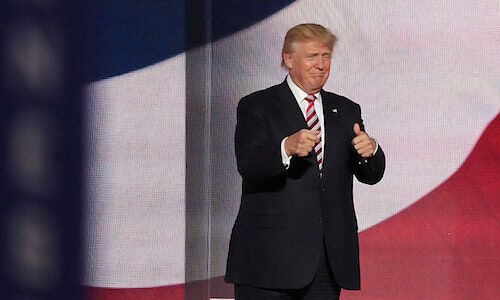Deutsche Bank: The Tech Wall of the Next Cold War
Rising tensions in U.S.-China relations is signaling the potential start of a new Cold War, according to research from Deutsche Bank, which could result in a wall splitting the world into two technology universes.
From artificial intelligence to telecommunications infrastructure, the U.S. and China have been actively competing head-on in various tech-related areas. Although the U.S. has recently added pressure to Chinese rivals like Huawei, the eastern counterpart has been consistently on the rise in recent years. As a ratio representing the tech gap between China and the U.S., Deutsche Bank’s research said that the former has climbed from 0.4 in 2015 to 0.6 in 2018.
Interestingly, the ratio dropped for the first time in 2019 to 0.5, suggesting possible effectiveness from U.S. President Donald Trump’s policies to slow China. Nonetheless, the bank expects tech parity to be reached between 2025 and 2030, in line with China’s goals.
«As the 'Tech Cold War' continues unabated, there is a growing inclination from both sides to create their own tech regimes,» according to recent research authored by Deutsche Bank analyst Apjit Walia. «We believe this has the potential to reach a crescendo when both sides end up creating a 'Tech Wall' with little or no inter-operability.»
Cold War 2.0?
Using machine learning from Deutsche Bank's big data platform dbDig to track related mentions on newswire in a «DB Tech Cold War Index» to provide an indicator on tech-related tension levels. Currently, signs indicate not only the beginnings of a Cold War but rapid escalation over the past five years.
In addition to intensification caused by tit-for-tat tech-related measures, the index reached an all-time high in April 2020 due to a strong reaction from the U.S. administration with regards to the coronavirus pandemic.
«At the root of this cold war is a view by the US administration that China is engaging in forced IP transfer and 'innovation mercantilism’,» the report said. «The Chinese administration view is that they are migrating from a 'factory of the world model' to a global innovation hub model, and technology supremacy is a natural national priority.»
Not U.S.S.R.
The report noted that the potential upcoming Cold War has two major differences from the previous one. Firstly, the U.S. won the last innovation race by simply outspending the U.S.S.R. whereas the current administration is embarking on policy more focused on slowing down the opposition.
Secondly and more importantly, there was limited co-dependence between the previous two blocs compared to the current pair which has achieved a high level of integration since the 1970s.
«To detangle that will be extremely painful and costly,» the report added. «Cold wars, once they start tend to go on for several decades and the following chart shows how early we might be in the stages of the current one.»
Costly and Unwelcome
A world with two separate technology regimes of limited interoperability is costly and unwelcome by all. Corporates would need to deploy two communications and networking standards, diminishing benefits from scalability. Regular individuals are expected to suffer the most from the geopolitical conflict in addition to existing coronavirus headwinds.
«The irony of this whole multi-decade saga is that history tells us that technology cannot be monopolized by anyone for too long, sheer diffusion ensures it spreads ubiquitously,» the report concludes.
«An objective observer hopes this reality is dawned on the two tech regimes and administrations sooner rather than later.»






















